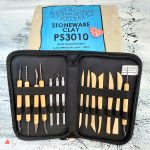Description
Love Gardening? Want to be more sustainable?
Make your own Olla (ancient irrigation system for your garden)
Saturday September 14th : 1-4pm
Classes limited to eight so book early.
There will be no communal water cups, aprons or towels, so please bring your own. Hand sanitiser will be available upon entry to the studio.
$115 includes all materials, tuition and kiln firing.
As seen on Gardening Australia!
During this 3 hour workshop you shall make your own Olla using terracotta clay and the coil building method. Your Olla will hold approximately 3-4 litres of water, and we will also make a lid.
Your garden creation will remain at the studio to dry and be kiln fired.
Once you learn the making method you can make as many as you need at home for your garden and bring them into the studio for kiln firing.
Read on to learn more about this ancient irrigation technique…
What is an Olla?
An Olla is an ancient watering/irrigation system constructed with unglazed porous clay pots.
– Olla is the Spanish word for “pot” and is a clay pot used for irrigation.
– Ollas can save 30% to 70% of the water used by other irrigation methods
– Veggies and flowers LOVE Ollas, because they provide just the right amount of water exactly when the plants need it.
– Installing an Olla is simple, just dig a hole, bury the pot and fill it with water!
– One 3 litre Olla will irrigate a 60 x 60cm garden bed.
Ollas may be the most efficient method of local plant irrigation in drylands known to humanity due to the microporous (unglazed) walls that do “not allow water to flow freely from the pot, but guides water seepage from it in the direction where suction develops. When buried neck deep into the ground, filled with water, and crops planted adjacent to it, the clay pot effects sub-surface irrigation as water oozes out of it due to the suction force which attracts water molecules to the plant roots. The suction force is created by soil moisture tension and/or plant roots themselves.” (AE Daka – 2001.) The plant roots grow around the pots and only “pull” moisture when needed, never wasting a single drop. “Ollas virtually eliminate the runoff and evaporation common in modern irrigation systems, allowing the plant to absorb nearly 100 percent of water.” (City of Austin Water Conservation, 2006.)
To use ollas in a garden or farm, one buries the olla in the soil leaving the top slightly protruding from the soil (ideally the neck of the olla is glazed to prevent evaporation or it should be reasonable to apply a surface mulch that covers the neck of the olla without spilling into the opening). The olla is filled with water and the opening is then capped (with a rock, clay plate or other available material to prevent mosquito breeding, soil intrusion and evaporation).
“Depending on factors such as the plant’s water needs, soil type, time of year, and environment ollas may need filling weekly or daily. Water usually takes between 24 and 72 hours to flow through an olla.” (Bulten, 2006) Water should be added to an olla whenever the water level in the olla falls below 50% in order to avoid build up of salt residues along surfaces of the olla that may prevent desired seepage.
(https://permaculturenews.org/2010/09/16/ollas-unglazed-clay-pots-for-garden-irrigation/)
Image courtesy: http://www.plugandplaygardens.com/olla-clay-pot-irrigation/spring-sale-20-off-2-gallon-ollas/
More Olla making fun from previous workshops can be seen on the Claymotion FACEBOOK and INSTAGRAM pages – so be sure to follow us for updates.
Please read ClayMotion Terms & Conditions HERE









Alissa (verified owner) –
Absolutely loved the olla making class! Excited to make more of them over the Xmas break (I’ve just been to the studio today to buy terracotta clay). Thanks Dawn!!